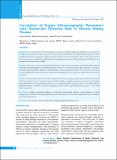Please use this identifier to cite or link to this item:
https://hdl.handle.net/20.500.14356/1429| Title: | Correlation of Duplex Ultrasonographic Parameters with Glomerular Filtration Rate in Chronic Kidney Disease |
| Authors: | Devkota, Karun Gupta, Mukesh Kumar Pant, Ashok Raj Karki, Prahlad |
| Citation: | DevkotaK., GuptaM. K., PantA. R., & KarkiP. (2019). Correlation of Duplex Ultrasonographic Parameters with Glomerular Filtration Rate in Chronic Kidney Disease. Journal of Nepal Health Research Council, 17(01), 32-37. https://doi.org/10.33314/jnhrc.v17i01.1277 |
| Issue Date: | 2019 |
| Publisher: | Nepal Health Research Council |
| Article Type: | Original Article |
| Keywords: | Chronic kidney disease Duplex ultrasonography Glomerular filtration rate |
| Series/Report no.: | Jan-March, 2019;1277 |
| Abstract: | Abstract Background: Chronic kidney disease encompasses a spectrum of different pathophysiological processes associated with abnormal renal function and a progressive decline in glomerular filtration rate. Duplex ultrasonography is widely available and important imaging investigation required in the work?up of chronic kidney disease. The objective of the study was to assess correlation of renal duplex ultrasonographic parameters with decreased glomerular filtration rate in patients with chronic kidney disease. Methods: This was a crosssectional hospital-based study. A total of sixty-two patients with chronic kidney disease referred for ultrasonography were included in the study. Patients were evaluated by duplex ultrasonography. Correlation of renal length, parenchymal thickness, cortical thickness, cortical echogenicity, peak systolic velocity, end diastolic velocity pulsatility index and resistive index with glomerular filtration rate was evaluated by using Pearson’s correlation coefficient. Results: Chronic kidney disease was seen more prevalent in 41-50 years of age group. The major risk factors associated with Chronic kidney disease was Hypertension and Diabetes Mellitus. A significant positive correlation of renal length, parenchymal thickness, cortical thickness (p value < 0.01) and end diastolic velocity (p value < 0.05) with eGFR and significant negative correlation of cortical echogenicity, resistive index and pulsatility index (p value < 0.01) with eGFR was derived. Conclusions: Duplex sonographic findings of renal length, parenchymal thickness, cortical thickness, cortical echogenicity, end diastolic velocity, pulsatility index and resistive index are found to be useful parameters in evaluation of chronic kidney disease. Keywords: Chronic kidney disease; duplex ultrasonography; glomerular filtration rate. |
| Description: | Original Article |
| URI: | http://103.69.126.140:8080/handle/20.500.14356/1429 |
| ISSN: | Print ISSN: 1727-5482; Online ISSN: 1999-6217 |
| Appears in Collections: | Vol. 17 No. 1 Issue 42 Jan - Mar 2019 |
Files in This Item:
| File | Description | Size | Format | |
|---|---|---|---|---|
| 1277-Manuscript-9265-2-10-20190430.pdf | Fulltext Download | 411.54 kB | Adobe PDF |  View/Open |
Items in DSpace are protected by copyright, with all rights reserved, unless otherwise indicated.
